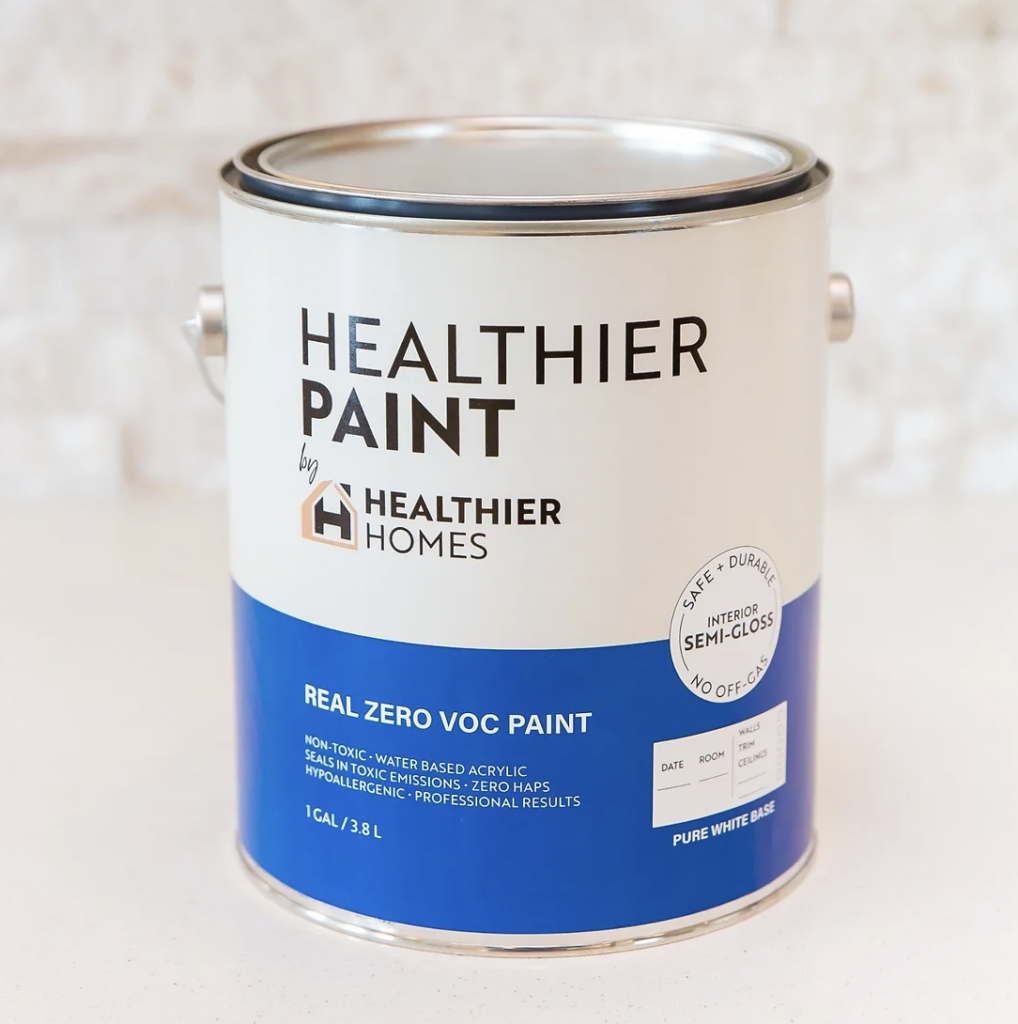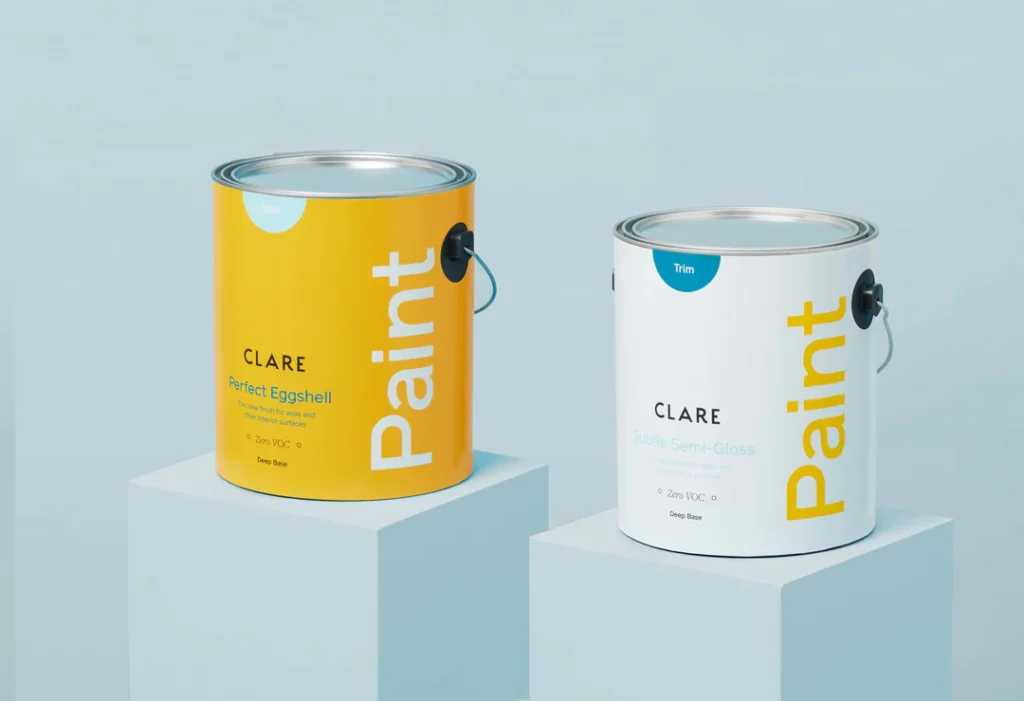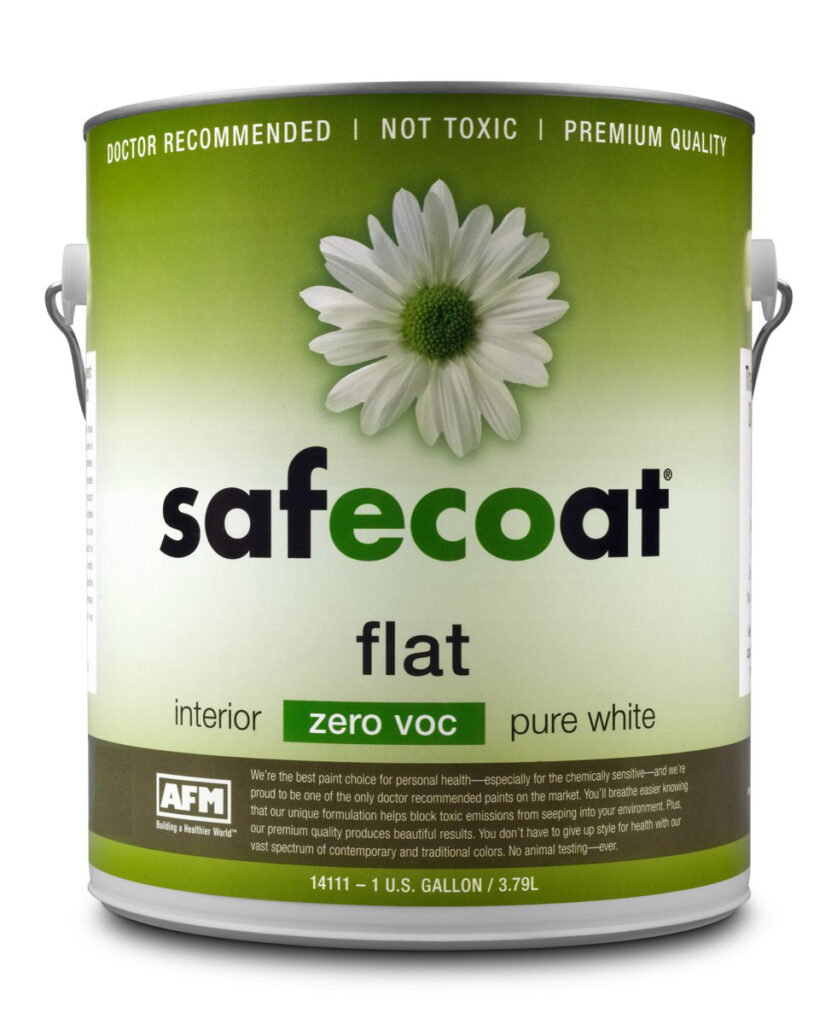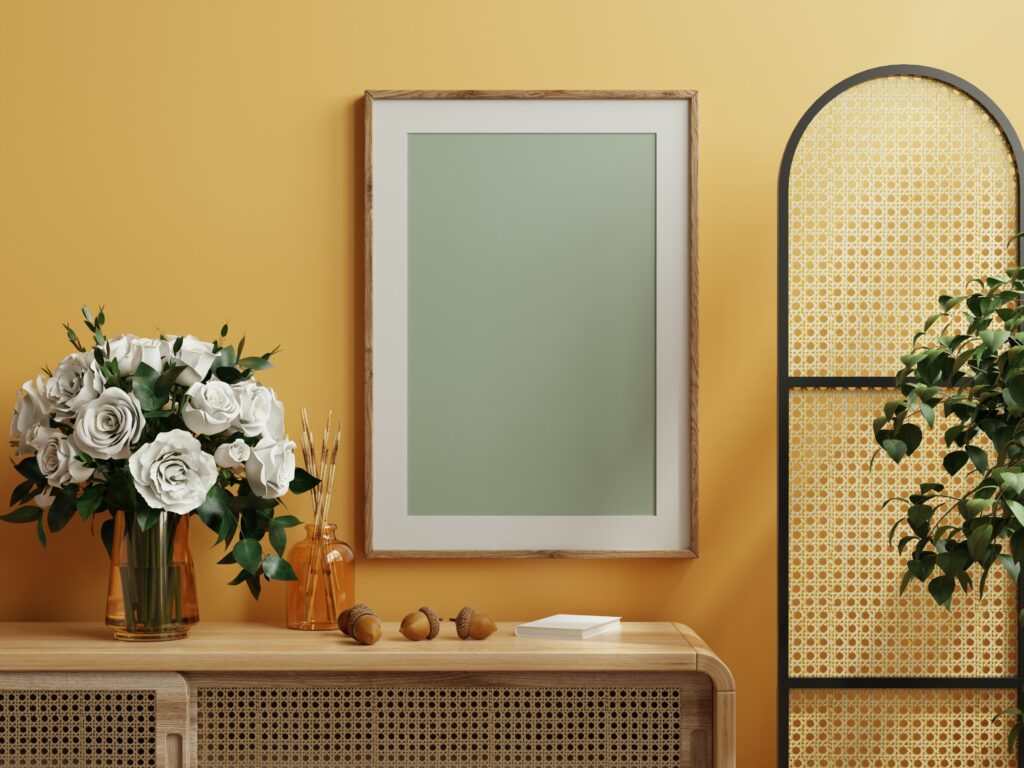Looking forward to painting your home? Here are the best brands of non toxic zero VOC paint to use for your project!
Everyone wants their home to look great, right? A fresh coat of paint can change the entire look and vibe of your room for a low-cost, high-impact update!
But making your home look its best should not compromise on your health. And if you are environmentally conscious, it should not harm the environment either. If these are things that are important to you, you might want to consider using non-toxic zero VOC paint for your next painting project.
It’s well-known that paints often contain toxic chemicals like benzene and lead. They also release compounds into the air called volatile organic compounds (VOCs) that pollute your indoor air quality. They can lead to various health problems while also contributing to environmental pollution. Since most of us spend 90% of our time indoors, we want to make sure we’re keeping that air as clean as possible.
When you use non-toxic zero VOC paint, you can avoid these risks and enjoy many benefits at the same time! These paints give you improved indoor air quality, reduced allergies and asthma, a lower carbon footprint, and enhanced durability.
If you’re curious about what non-toxic zero VOC paint is and how to find the best option for your needs, I’ll walk you through the best picks. I’ll also highlight some of the advantages and challenges of using this paint. And finally, we’ll give you tips and tricks on how to apply and maintain it as well as a few examples of some of the best brands of non-toxic zero VOC paint!
Let’s dive right in, shall we?
This post may contain commissionable links. Thank you for supporting this resource.

6 Best Non Toxic Zero and VOC Paint Brands
Here is a list of some of the best brands that offer non-toxic zero VOC paint options:
1. Healthier Homes Non Toxic Zero VOC Paint and Primer For Your Home
Price: $72+ per gallon
Finishes: 4 finishes, 1 lacquer, 1 sealant
Bonus: For every gallon of paint purchased, 100 ocean-bound plastic bottles are recycled.

Healthier Homes goes above and beyond with their paints offering durable, water-based formulas for interior and exterior use.
Their paints contain zero hazardous air pollutants (HAPs) and blocks off-gassing from a painted surface making them the best choice for your painting project, your family, and the environment!
Healthier Homes paints are easy to apply and have a smooth and creamy texture. They have excellent coverage and adhesion and can be used on a wide variety of surfaces.
Plus, they can color match colors and brands so you get the exact shade you’re looking for!
On top of that, Healthier Homes offers a wide range of home decor, rugs, and furniture to round out your non-toxic space!

2. ECOS Paints – A Paint For Every Project
Price: $88.75+ per gallon
Finishes: 10 paints, 4 finishes
Bonus: They give back to Habitat for Humanity in their home location – Spartanburg, South Carolina.

ECOS Paints is based in Spartanburg, South Carolina and proudly USA made. They offer a wide range of zero VOC paints for interior and exterior use.
They have a wide selection of color choices or you can have them color match a brand.
All of their paints are water-based and contain ingredients like kaolin clay, hydrogen peroxide, sodium salt, and mineral oil.
ECOS is well known for their quality and innovation. They have various types of paints for different purposes as well as unique products like EMR shielding paint, concrete filler, and pet-dwelling paint.
3. Clare Paint – A Sustainably Curated Color Palette
Price: $70+ per gallon
Finishes: 2 types, 2 finishes
Bonus: Clare paint is proudly female-founded and Greenguard Gold Certified.

Clare is an online brand that offers a curated selection of zero-VOC paint for interior use.
Their paints are water-based and use a proprietary colorant system that is also zero VOC. Their paints do not have any hazardous air pollutants or toxic air contaminants.
The brand believes in making painting easy and fun.
They offer free shipping and returns, peel-and-stick color swatches, and expert guidance. They have a simple color palette of 56 hues to suit any style and mood.
They do have a curated color selection and do not offer coloring matching. They are also only available online.
4. AFM Safecoat – Primers and Paints For Every Surface
Price: $72 per gallon
Finishes: 8 types, 4 sheens
AFM Safecoat is a brand that offers environmentally responsible, sustainable, and non-polluting paints.
They also make stains, wood finishes, sealers, and related green building products. Their products are formulated for the least possible toxicity. They also do not contain any synthetic preservatives, biocides, or fungicides.
AFM Safecoat paints use mineral pigments that are free of heavy metals and toxins. They are suitable for various surfaces and come in a wide range of finishes.
You do have to purcahse this paint through a dealer by calling or locating a store.

5. Green Planet Paints… Revolutionizing Paints – Naturally
Price: $65.99 per gallon (+$20 for custom colors)
Finishes: 2 finishes, 4 sheens
Green Planet Paints is a trailblazing brand that prioritizes environmental sustainability and health-conscious solutions.
Their innovative range of paints combines vibrant colors with a commitment to minimizing environmental impact. With a focus on reducing volatile organic compounds (VOCs) and using natural, eco-friendly ingredients, Green Planet Paints offers a wide palette of choices that not only beautify spaces but also promote indoor air quality.
Their dedication to responsible manufacturing, low VOC formulations, and adherence to stringent environmental standards makes them a standout choice for those seeking to create inspiring living and working environments while safeguarding the planet’s health.
Their paints exceed all USDA and EPA standards and are made from minerals, clays, plant oils and water born materials.
6. Real Milk Paint Co. – Powdered Paint
Price: $69.99 – $76 per gallon
Finishes: 1 sheen with additional products available to get the finish you desire
Real Milk Paint is a renowned brand celebrated for its authenticity and traditional craftsmanship. They have developed milk-based paints that are eco-friendly.
With a rich history centered around mimicking traditional antique furniture, their paint products are made from genuine milk protein, creating a unique and organic finish.
This environmentally conscious brand embraces natural ingredients and natural pigments offering a safe and non-toxic alternative for both interior and exterior applications.
The natural paints from Real Milk Paint Co. comes powdered and you self-mix it with water before painting.

What You Need To Know About Non Toxic, Zero VOC Paint
What are VOCs and why are they harmful?
Let’s start with the basics.
As mentioned before, VOCs, or volatile organic compounds, are chemicals that can easily evaporate into the air we breathe. They have high vapor pressure at room temperature. This makes them easily evaporate into the air, turning into gases.
VOCs are found in many products. Common examples are paints, solvents, cleaners, adhesives, pesticides, cosmetics, and fuels.
When they are released into the air, they can cause various negative effects on human health and the environment.
Here are some of the long-term health effects of VOCs:
- Eye, nose, and throat irritation
- Headaches, dizziness, and fatigue
- Nausea, vomiting, and loss of coordination
- Allergic skin reactions
- Damage to the liver, kidney, and nervous system
- Cancer
They also affect the environment in the following ways:
- They lead to air pollution and smog formation
- They are one of the causes of climate change and global warming
- They lead to ozone depletion and acid rain
- They cause reduced visibility
According to the Environmental Protection Agency (EPA), indoor air can be up to 10 times more polluted than outdoor air due to the presence of VOCs.
When you consider the fact that most people spend 90% of their time indoors, this number is highly concerning. This is why it is so important to reduce the exposure to VOCs in your home.
In recent years, there has been more consumer demand for eco-friendly paints, and this is a good thing!

How to identify non-toxic zero VOC paint?
Nontoxic zero VOC paint is a type of paint that does not contain any VOCs or other harmful ingredients. Non-toxic zero VOC paint is usually made from natural or plant-based materials like water, clay, minerals, oils, resins, pigments, and essential oils.
To identify non-toxic zero VOC paint, here is what you need to look for:
- Labels: Check the labels on the paint cans or containers. Look for terms like “zero VOC”, “low VOC”, “no VOC”, “VOC-free”, or “non-toxic”. However, be aware that some paints may claim to be zero VOC but still contain small amounts of VOCs or other chemicals. Always read the fine print to verify any claims that are made on the labels.
- Ingredients: Look for the list of ingredients on the paint containers or the manufacturer’s website. Avoid paints that contain synthetic or petroleum-based ingredients like acrylics, vinyl, alkyds, urethanes, formaldehyde, glycols, ethylene oxide, ammonia, or biocides. Instead, look for paints that contain natural or plant-based materials like water, clay, minerals, oils, and resins.
- Check the SDS (material safety data sheet): The safety data sheets will disclose more information about a product and how it was tested for safety.
Certification to Look For
Look for certifications from reputable organizations that verify the quality of the paint. Some examples of certifications are Green Seal, Greenguard, EcoLogo, Cradle to Cradle, or USDA Organic.
- GREENGUARD examines paint formulations and production methods to identify volatile organic compounds (VOCs) and harmful chemicals.
- Green Wise subjects products to independent testing to ensure they meet or surpass VOC standards. It also prohibits specific chemical components like methylene chloride, phthalates, and formaldehyde, as well as heavy metals such as cadmium, lead, and mercury.
- Cradle to Cradle assesses products using five sustainability criteria: material health, product recyclability, air and climate cleanliness, water and soil stewardship, and equitable social practices.
- Green Seal grants certifications to paints, coatings, and adhesives that adhere to low-VOC levels and safer formulations.
You should also always read user reviews and testimonials from other customers who have used the paint before buying. This will help you figure out whether what you are planning to get is exactly what you want or not.

What does “Low VOC” and “Zero VOC” mean?
“Low VOC” and “Zero VOC” are terms used to describe the levels of volatile organic compounds (VOCs) in paint and other products. VOCs are chemicals that can evaporate into the air and contribute to air pollution and potential health problems.
Here’s the difference between the two:
Low VOC Paint: “Low VOC” refers to paint products that contain a reduced amount of volatile organic compounds compared to traditional paints. While the specific threshold for what qualifies as “low-VOC paint” can vary by region and regulatory standards, it generally means that the paint contains significantly fewer VOCs than traditional paints. Low VOC paints are formulated to have reduced emissions of harmful chemicals into the air, which can lead to better indoor air quality and less environmental impact. This term means that the paint has less than 50 grams of VOCs per liter.
Zero VOC Paint: “Zero VOC” paint, as the name suggests, is paint that contains negligible or no detectable levels of volatile organic compounds. Zero VOC paints are formulated to have extremely low levels of VOCs, typically below the detection limit of most testing methods. This makes them among the least environmentally impactful and least likely to contribute to indoor air pollution. Zero VOC paints are often preferred in situations where air quality and environmental impact are of utmost concern, such as in healthcare facilities, homes with sensitive occupants, or environmentally conscious building projects. This term means that the paint has less than 5 grams of VOCs per liter.
Zero VOC paint is the better choice. You should always review the safety data sheets and ingredients instead of relying on marketing that says “non-toxic” because this, unlike low and zero VOC, is not a regulated term.
The Advantages of Non-Toxic and Zero VOC paint
Choosing non-toxic zero VOC paint isn’t just a trend; it’s a wise decision for several reasons. Here are some of them:
- Improved indoor air quality: Say goodbye to that unpleasant paint smell lingering on for days. Non-toxic paints release fewer harmful fumes, ensuring better indoor air quality and a safer living environment.
- Reduced allergies: Paints laden with VOCs can trigger allergies and worsen asthma symptoms. Non-toxic paints help create a healthier space. This is quite useful especially if you have respiratory sensitivities.
- Lower carbon footprint: For the environmentally conscious consumer, it is great to know that the production and use of non-toxic zero VOC paints has very low carbon emissions. This means when you choose these paints, you are taking steps to lower your carbon footprint and build a more sustainable planet.
- Durability: Non-toxic paints have high-quality formulas that ensure vibrant colors that stand the test of time.
The Challenges of Non-Toxic and Zero VOC Paints
While the benefits are compelling, it’s essential to acknowledge the challenges too. Here are some of them:
- Higher cost: They can be pricier than conventional options. However, considering the long-term benefits, the investment is often worth it.
- Limited color options: While the range of available colors has improved, you might still find a slightly narrower palette compared to traditional paints. Brands like Healthier Homes can color match while other brands, like Clare, only have a limited range.

How To Apply Non-Toxic and Zero VOC Paint
It may or may not surprise you to know that painting with non-toxic paint is mostly the same as regular paint!
Apply your non-toxic zero VOC paint to any surface by following these simple steps:
- Step 1 – Surface preparation: Before applying the paint, prepare the surface by cleaning and priming it. Remove any dirt, dust, grease, or loose paint from the surface. Use a damp cloth with a mild detergent or a vacuum cleaner to do this. Then sand the surface lightly with fine-grit sandpaper to smooth out any rough or uneven areas. You should also repair any cracks or damages with a filler or putty. Finally, prime the surface with a non-toxic zero VOC primer to improve the adhesion of the paint.
- Step 2 – Ventilation: Even though non-toxic zero VOC paint does not emit any VOCs or other chemicals, you should still ventilate the area where you are painting. Open the windows and doors and use fans to circulate the air. This will help the paint dry faster and prevent any moisture buildup.
- Step 3 – Tools: Get your brushes, rollers, trays, and buckets. The size and type of tool you end up using will depend on your surface and the type of paint you are working with. Once you are done, be sure to clean and store all your tools appropriately.
- Step 4 – Techniques: Stir the paint well before and during use to mix the ingredients evenly. Next, pour it into a tray or a bucket. Dip your brush or roller into it. Be sure to load enough paint on the tool but not too much to avoid dripping. Spread the paint evenly on the surface with overlapping strokes. Finally, smooth out any bubbles or marks with a light pressure.
- Step 5 – Coats: Apply enough coats of non-toxic zero VOC paint to achieve the desired color and finish. Wait for each coat to dry completely before applying the next one. The actual drying time will differ from brand to brand, so be sure to follow the manufacturer’s recommendations on drying time and number of coats.

How to Maintain Non-Toxic Zero VOC Paint
Maintaining your painted surfaces doesn’t require any special tricks. That said, a little care goes a long way. Here’s what to do:
- Cleaning: Cleaning non-toxic zero VOC painted surfaces is not different from cleaning conventional ones. Use mild soapy water and a soft cloth to gently clean away dirt and grime.
- Repairing: You can repair damaged painted areas with some leftover paint. Just touch it up a bit by following the same application process above.
- Repainting: When the time comes to refresh your walls, you’ll find that non-toxic paints are quite easy to work with. Simply prepare your surface as before and reapply the paint by following the same steps outlined above.
What are alternatives to VOC paints?
The alternatives to paint made with VOCs are zero VOC paints including paint from Healthier Homes, Clare, and ECOS.
What kind of paint is the least toxic?
Paint made with non-toxic ingredients, natural ingredients and tested for VOCs. Top brands include Healthier Homes, Clare, and ECOS.
You want to look for water-based paint over oil-based paint.
Is VOC paint toxic?
Yes, most traditional paint and conventional paint has VOCs and HAPs – these are toxic to human health. These often come with that new paint smell that can keep you out of your house for days.
The good news is that nontoxic paint is low odor and many times there is no paint smell with these natural materials.
Is Home Depot paint VOC free?
No, the Home Depots in my area do not carry non-toxic or zero VOC paint.

Final Thoughts on Non-Toxic and Zero VOC Paint
These days, many of the choices we make can have a lasting impact on our health and the environment. That’s why choosing to use non-toxic zero VOC paint is a smart move.
As we have seen, not only do these paints enhance indoor air quality, but they also reduce the risk of health issues. At the same time, they also contribute to a greener planet.
So, whether you’re embarking on a home improvement project or simply looking to add a fresh coat of color to your space, consider trying non-toxic zero VOC paint. And with the tips, tricks, and recommendations outlined above, making your spaces truly shine with a fresh coat of sustainable paint is finally within reach! Good luck!
More Eco Friendly Living:
- Eco-Friendly Holiday Gift Guide: 15 Gifts To Give That Are Better For The Environment
- 11 Best Eco Friendly Christmas Cards 2022
- 12 Affordable Eco Friendly Swimwear Brands For Every Body (2023)
- Eco Friendly Alternatives To Aluminum Foil – 9 Picks
- 6 Zero Waste Laundry Strips
- 10 Zero Waste Laundry Strips To Try
- America the Wasteful: A Detailed Look Into Our Throw-Away Society
- The 6 Best Non-Toxic Coffee Mugs
- 10 Best Decaf Organic Coffee Brands (2023) – Must Try!
- 10 Best Organic Flavored Coffee Brands [2023]
- 11 Best Non-Toxic Coffee Maker Picks 2023
- Caraway Cookware Review: Is It Worth It?
- 8 Organic Cotton Padded Bra Options [2023]
- 6 Best Organic Tinted Moisturizer with SPF Picks for Flawless Skin
- Best Non-Toxic Facial Moisturizer For All Skin Types
- 7 Best Organic Shoes for Men – Sustainable Shoe Brands 2023
- 4 Best Organic Wine Clubs and Subscriptions (2023)
- 6 Best Non Toxic Zero Paints For a Healthy Home
- 19 Affordable Non-Toxic Makeup Brands You Have To Try
- 15 Affordable Non-Toxic Skin Care Brands
- The Best Non-Toxic Dinnerware for Healthy Eating
- The Best Non-Toxic Cookware For Healthy Eating
- Best Non-Toxic Facial Moisturizer For All Skin Types
- The Best Non-Toxic Candles
- 25 Non Toxic Indoor Plants: Safe For Pets and Kids


